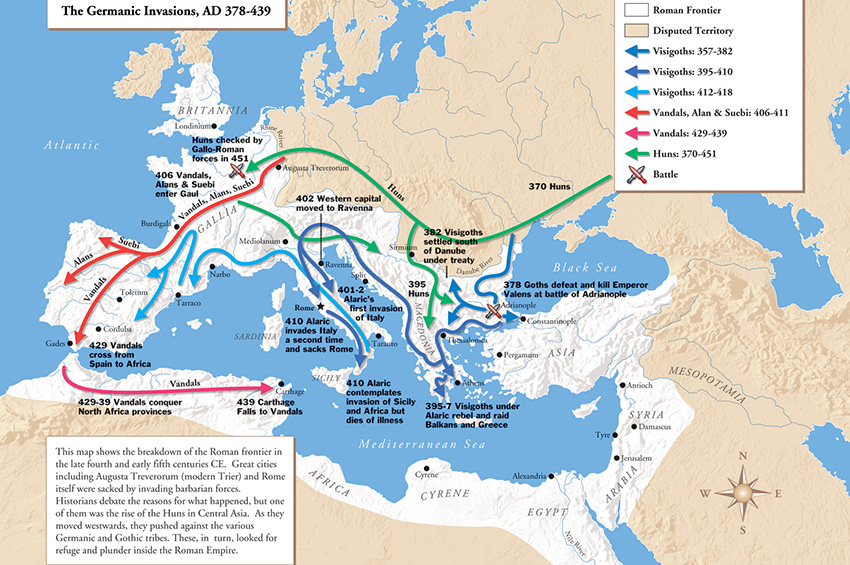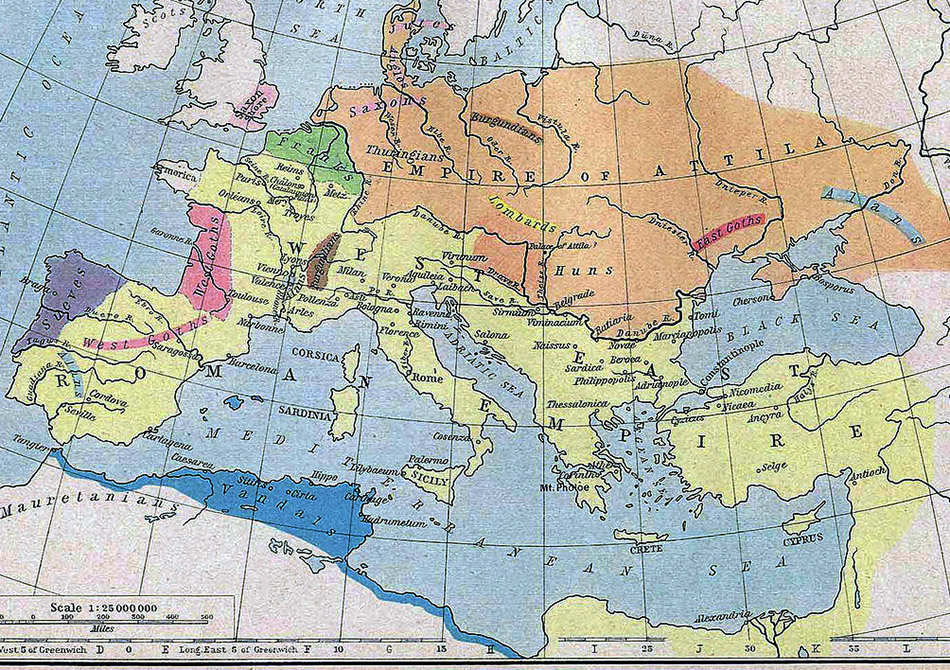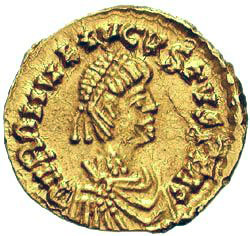Eastern Roman Emperor Arcadius (395-408 AD) and Honorius (393-423 AD) as Western Roman Emperor did not really agree in politics. Arcadius even saw an opportunity to be freed from the Visigoths (Western Goths) dangers by asking them to come to the West. Arcadius made a deal with Visigoth leader Alaric and he promise to give Visigoths Illyrian provinces on the Balkan Peninsula.
Alaric accepted the proposal, because he wanted to provide food and better living conditions for his own people. For Arcadius that was killing two birds with one stone, because no matter whether Visigoth will succeed, he took them off his back. The only firm hand in the West, which was somewhat able to keep things under control, was Theodosius military leader Stilicho, which was killed by orders from a silly Honorius. This act made an army of the West terribly weakened. In such conditions it was almost impossible to defend Rome. Honorius had neither the power nor the knowledge to organize something. Besides that he was completely isolated from events, since he was at his court in Ravenna and he never saw Rome.
Visigoths led by Alaric from Illyrian province went to Rome, which was looted in 410 AD. Something unthinkable has happened for Rome and Romans, the Eternal City, which resisted for the last eight centuries, fell into the hands of uncivilized conquer. After Alaric’s death, the Visigoths did not stay for long in Italy. Visigoths crossed the Alps and came to the area of Gaul where they settled and formed their Visigoth Kingdom. At the high peek of their power, in the middle of the fifth century, the Visigoths had spread from Gibraltar to the river Loire. Franks invaded them in the sixth century, and Saracens destroyed their kingdom in Hispania during the eighth century.



The next big Germanic tribe which was pressured by the Huns, which pressured the Roman borders, was the tribe of the Vandals. Vandals immediately went to conquer the south and Gaul, but they were stuck on the Rhine river, since they were unable to cross it. However, the natural and climatic conditions allowed them to cross it on the last day of the 406 AD. According to contemporaries, the Rhine was frozen with sufficient quantity of ice which allowed the Vandals and the rest of the troops to swarm across the Rhine at Mainz and burst into Gaul. Vandals did not spend much time in Gaul, since with the arrival of the Visigoths in Italy they were pressed towards the south and Hispania. Under the leadership of Vandals king Genseric, Vandals crossed over the Straits of Gibraltar to North Africa, which was full of rich cities, which gave them material to plunder for an entire decade. Upon completion of plundering of the cities, a Vandal Kingdom was established in the North Africa, with the center of Carthage.
Vandals have become a very powerful force in the western Mediterranean. Their fleet controlled the island of Corsica, Sardinia and even Sicily, and in 455 AD they robbed even Rome. Vandals’ with they brutality in the persecution of Non-Arians Christians and pirate attacks in the Mediterranean as well as unnecessary violence gained a negative reputation. The term vandal and vandalism to this day refers to all uncivilized practices against people or cultural achievements. But, once fearsome warriors, because of wealth became weaker, corrupted and disorganized, which later made it easier for the Emperor Justinian (527-565 AD) and the Eastern Roman Empire to conquest Vandal kingdom.



Nearly half a century Huns were quite quiet and peaceful. When they got a new leader, Attila, or as it was called in the West Flagellum Dei (Scourge of God), open confrontations with the Rome started. The Huns led by Atilla founded their horde on the plains of Middle Danube, in the Pannonian plain. In the initial phase Attila has even collaborated with the Roman general Flavius Aetius, who used him in conflicts against other Germanic tribes. With time, Attila became stronger and he began to undertake plundering bursts into the Eastern Roman Empire, which attempted to get rid of him by bribery and by paying him an annual tribute in gold. However, the East did not have the money to waste so at one point the eastern Emperor Marcian (450-457 AD) sent a message to Attila: “I have no more gold for you, only iron!” Attila realized that it was no longer fun in the East, and he retreated to Roman province Pannonia.
The real war with the West happened due to a woman. A sister of the Western Emperor Valentinian III (425-455 AD), Justa Grata Honoria, was caught with one servant but she was ordered to marry to an old senator. Honoria sent the message and ring to Attila in order to help her, and Attila demanded all Roman treasury and he wanted half of the western Empire as dowry. Valentinian III refused that, and Atilla declared him war.
Attila with a huge army entered in Gaul, where took place in 451 AD at Catalaunian plains a decisive battle. Roman (not just Roman, because Visigoths, Saxons, Franks, Burgundians participated in the battle…) army was led by a brilliant strategist Aetius, which forced Attila to retreat. Attila returned the following year and burst into northern Italy and robbed Milan. Rome was his next target, but on the way he was welcomed by Pope Leo I, who persuaded him to go back. Why Attila spared Rome remained unclear. Some argued that he was a bit scared that he insulted the Christian God, while cynics argued that at this meeting several bags of gold changed their owners. Whatever the case, Attila returned to Pannonian province, where he died the following year from the consequences of hemorrhoids, after a heated drunk wedding party. He married Germans Ildico. Hunnic empire immediately fell apart, and the remaining Huns retreated to the East.
Western Roman Empire during the fifth century AD was completely exhausted. The economy almost did not exist, and the state government was powerless to stop all this looting and Germanic and Huns invasions. Besides that, the imperial government was fully depended on the commanders of barbarian troops in the Roman army. They proclaimed one king in one moment; in the other they would proclaim some other king.



In 474 the Emperor in the West was appointed Julius Nepos (474-475 AD), who was installed by the eastern Emperor and thus he had some dignity. Nepos’s named Orestes as a chief military commander, who was a former Atillia army commander. Orestes began pressuring to appoint his son Romulus Augustus as the Emperor and the Emperor while Emperor Nepos fled to Salona, in the Diocletian’s Palace. Romulus nickname was Augustulus or Little Augustus. Romulus Augustus in Ravenna was proclaimed as an Emperor, but this act had no legal significance and in the East people still accepted as a legal Emperor – Julius Nepos.
The next year, 476 AD, a Germanic warlord Odoacer killed Orestes, after which he moved Romulus Augustus from the imperial position, and all signs of imperial rule were sent to the eastern Emperor Zeno in Constantinople. Odoacer crowned himself as the king of Italy, and the transfer of power went so smoothly that he did not even killed a former Emperor Romulus Augustus, but he situated him in a villa near Naples with a good pension, where he lived nicely until 511 AD.
